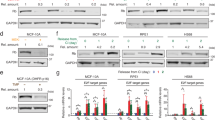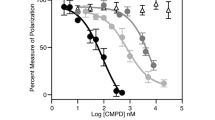Abstract
Inactivation of the retinoblastoma (Rb) tumor suppressor protein is essential for the G1/S transition during mammalian cell cycle progression. Although Rb is inactivated by phosphorylation by cyclins D and E and their associated kinases during cell cycle progression, we find that Rb is inactivated upon apoptotic stimulation by Fas through the mediation of p38 kinase, independent of cyclins and cyclin-dependent kinases (cdks). Inactivation by p38 kinase coincided with increased phosphorylation of Rb leading to dissociation of E2F and increased transcriptional activity; such p38-mediated changes in Rb function occurred only during Fas stimulation but not mitogenic progression. p38 kinase targets Rb preferentially and had minimal effects on p107 and had no effect on p130 function. We also find that phosphorylation site mutants of Rb (PSM7LP and PSM9-Rb) that cannot be inactivated by cdks can be targeted by Fas and p38 kinase, suggesting that Rb inactivation by these kinases is biochemically and functionally distinct. It appears that Rb inactivation is achieved by different kinase cascades in response to mitogenic and apoptotic signals.
This is a preview of subscription content, access via your institution
Access options
Subscribe to this journal
Receive 50 print issues and online access
$259.00 per year
only $5.18 per issue
Buy this article
- Purchase on Springer Link
- Instant access to full article PDF
Prices may be subject to local taxes which are calculated during checkout





Similar content being viewed by others
References
Adams PD and Kaelin WJ . (1995). Semin. Cancer Biol., 6, 99–108.
Adams PD and Kaelin WJ . (1996). Curr. Top. Microbiol. Immunol., 208, 79–93.
Asano M, Nevins JR and Wharton RP . (1996). Genes. Dev., 10, 1422–1432.
Bates S, Phillips AC, Clark PA, Stott F, Peters G, Ludwig RL and Vousden KH . (1998). Nature, 395, 124–125.
Brehm A, Miska EA, McCance DJ, Reid JL, Bannister AJ and Kouzarides T . (1998). Nature, 391, 597–601.
Chellappan S, Kraus VB, Kroger B, Munger K, Howley PM, Phelps WC and Nevins JR . (1992). Proc. Natl. Acad. Sci. USA, 89, 4549–4553.
Chellappan SP, Hiebert S, Mudryj M, Horowitz JM and Nevins JR . (1991). Cell, 65, 1053–1061.
Chen WD, Otterson GA, Lipkowitz S, Khleif SN, Coxon AB and Kaye FJ . (1997). Oncogene, 14, 1243–1248.
DeGregori J, Leone G, Miron A, Jakoi L and Nevins JR . (1997). Proc. Natl. Acad. Sci. USA, 94, 7245–7250.
DeGregori J, Leone G, Ohtani K, Miron A and Nevins JR . (1995). Genes Dev., 9, 2873–2887.
Dou QP, An B, Antoku K and Johnson DE . (1997). J. Cell. Biochem., 64, 586–594.
Dyson N . (1998). Genes Dev., 12, 2245–2262.
Field SJ, Tsai FY, Kuo F, Zubiaga AM, Kaelin WJ, Livingston DM, Orkin SH and Greenberg ME . (1996). Cell, 85, 549–561.
Harbour JW and Dean DC . (2000a). Nat. Cell. Biol., 2, E65–E67.
Harbour JW and Dean DC . (2000b). Genes Dev., 14, 2393–2409.
Harbour JW, Luo RX, Dei Santi A, Postigo AA and Dean DC . (1999). Cell, 98, 859–869.
Helin K . (1998). Curr. Opin. Genet. Dev., 8, 28–35.
Hou ST, Callaghan D, Fournier MC, Hill I, Kang L, Massie B, Morley P, Murray C, Rasquinha I, Slack R and MacManus JP . (2000). J. Neurochem., 75, 91–100.
Hseih J-K, Fredersdorf S, Kouzarides T, Martin K and Lu X . (1997). Genes Dev., 11, 1840–1852.
Irwin M, Marin MC, Phillips AC, Seelan RS, Smith DI, Liu W, Flores ER, Tsai KY, Jacks T, Vousden KH and Kaelin Jr WG . (2000). Nature, 407, 645–648.
Ishida S, Huang E, Zuzan H, Spang R, Leone G, West M and Nevins JR . (2001). Mol. Cell. Biol., 21, 4684–4699.
Juo P, Kuo CJ, Reynolds SE, Konz RF, Raingeaud J, Davis RJ, Bieman H-P and Blenis J . (1997). Mol. Cell. Biol., 17, 24–35.
Knudsen ES and Wang JY . (1996). J. Biol. Chem., 271, 8313–8320.
Knudsen ES and Wang JY . (1997). Mol. Cell. Biol., 17, 5771–5783.
Lee JO, Russo AA and Pavletich NP . (1998). Nature, 391, 859–865.
Lissy NA, Davis PK, Irwin M, Kaelin WG and Dowdy SF . (2000). Nature, 407, 642–645.
Luo RX, Postigo AA and Dean DC . (1998). Cell, 92, 463–473.
Magnaghi-Jaulin L, Groisman R, Naguibneva I, Robin P, Lorain S, Le Villain JP, Troalen F, Trouche D and Harel-Bellan A . (1998). Nature, 391, 601–605.
Moroni MC, Hickman ES, Denchi EL, Caprara G, Colli E, Cecconi F, Muller H and Helin K . (2001). Nat. Cell. Biol., 3, 552–558.
Muller H, Bracken AP, Vernell R, Moroni MC, Christians F, Grassilli E, Prosperini E, Vigo E, Oliner JD and Helin K . (2001). Genes Dev., 15, 267–285.
Muller H and Helin K . (2000). Biochim. Biophys. Acta, 1470, M1–M12.
Nath N, Bian H, Reed EF and Chellappan SP . (1999). J. Immunol., 162, 5351–5358.
Nevins JR . (1992). Science, 258, 424–429.
Nevins JR . (1998). Cell Growth Differ., 9, 585–593.
Nevins JR . (2001). Hum. Mol. Genet., 10, 699–703.
Phillips AC and Vousden KH . (2001). Apoptosis, 6, 173–182.
Qin XQ, Livingston DM, Kaelin WJ and Adams PD . (1994). Proc. Natl. Acad. Sci. USA, 91, 10918–10922.
Ren B, Cam H, Takahashi Y, Volkert T, Terragni J, Young RA and Dynlacht BD . (2002). Genes Dev., 16, 245–256.
Shan B and Lee WH . (1994). Mol. Cell. Biol., 14, 8166–8173.
Sherr CJ . (1994). Trends Cell Biol., 4, 15–18.
Takahashi Y, Rayman JB and Dynlacht BD . (2000). Genes Dev., 14, 804–816.
Tan X, Martin SJ, Green DR and Wang JYJ . (1997). J. Biol. Chem., 272, 9613–9616.
Tan X and Wang JYJ . (1998). Trends Cell Biol., 8, 116–120.
Taya Y . (1997). Trends Biochem. Sci., 22, 14–17.
Wang JY . (1997). Curr. Opin. Genet. Dev., 7, 39–45.
Wang S, Ghosh R and Chellappan S . (1998). Mol. Cell. Biol., 18, 7487–7498.
Wang S, Nath N, Minden A and Chellappan S . (1999). EMBO J., 18, 1559–1570.
Weinberg RA . (1995). Cell, 81, 323–330.
Wu X and Levine AJ . (1994). Proc. Natl. Acad. Sci. USA, 91, 3602–3606.
Yang HL, Dong YB, Elliott MJ, Liu TJ and McMasters KM . (2000). Clin. Cancer Res., 6, 1579–1589.
Acknowledgements
This work was supported by Grant CA63136 from the NCI to SPC.
Author information
Authors and Affiliations
Corresponding author
Rights and permissions
About this article
Cite this article
Nath, N., Wang, S., Betts, V. et al. Apoptotic and mitogenic stimuli inactivate Rb by differential utilization of p38 and cyclin-dependent kinases. Oncogene 22, 5986–5994 (2003). https://doi.org/10.1038/sj.onc.1206843
Received:
Revised:
Accepted:
Published:
Issue Date:
DOI: https://doi.org/10.1038/sj.onc.1206843
Keywords
This article is cited by
-
Diversity within the pRb pathway: is there a code of conduct?
Oncogene (2012)
-
p38 phosphorylates Rb on Ser567 by a novel, cell cycle-independent mechanism that triggers Rb–Hdm2 interaction and apoptosis
Oncogene (2011)
-
Induction of Uncoupling Protein‐1 in Mouse Embryonic Fibroblast‐derived Adipocytes by Retinoic Acid
Obesity (2010)
-
Transferrin-receptor-mediated iron accumulation controls proliferation and glutamate release in glioma cells
Journal of Molecular Medicine (2009)
-
The retinoblastoma tumor-suppressor gene, the exception that proves the rule
Oncogene (2006)



